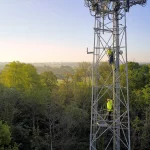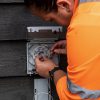Challenges as UK ISPs Start Advertising Average Broadband Speeds
Starting today all broadband offering Internet Service Providers (ISP) in the United Kingdom will be expected to change how they advertise service speeds, primarily by only promoting “average” speeds (a median measured at peak time) for their headline packages instead of an “up to” (fastest 10%) figure.
The existing guidance, which has been in place since 2012, only requires that headline speeds should be achievable by at least 10% of an ISPs users (i.e. the fastest 10% on a specific package / connection) and these figures must be preceded by an “up to” qualifier. On top of that the ISP must also explain any limitations that may affect the user’s speed.
For example, a normal ADSL2+ based copper broadband line (these are still used by most UK premises) can theoretically deliver a maximum download speed of 20-24Mbps but under the current rule this would become “up to” around 17Mbps. However the Advertising Standards Authority’s (ASA) new rule means that you’re more likely to see this promoted as an “average speed” (speed achievable by 50% of customers) of around 11Mbps or less.
Advertisement
The decision to score performance by “peak time” (8pm to 10pm) means that ISPs will be displaying an average for a part of the day when their networks are under the heaviest load, which means that the speed displayed is more likely to factor in the impact of network congestion or Traffic Management. As a result the ASA believes that consumers will gain a “better indication of the actual speeds [they] are likely to experience.”
Guy Parker, CEO of the ASA, said:
“From today, consumers will see a difference in broadband ads that make claims about speed as this new, tougher, standard is enforced. We’ll be making sure consumers aren’t misled by speed claims in ads, not least because choosing the right broadband deal has become such an important part of running a household or business.”
Andrew Glover, ISPA Chair, said:
“ISPA welcomes the new Advertising Standards Agency (ASA) guidelines coming into force today [Wednesday 23rd May] as an important step in bringing greater clarity to consumers. ISPA provided input to the ASA during the consultation phase of the reform to the guidance, and was supportive of a move to include speed estimates that more accurately reflect the experience of the majority of users.
ISPA members are committed to meeting the new obligations regarding median averages, and clearly setting out all the relevant information to consumers before they sign up. ISPA notes that while this is a significant move towards greater consumer understanding and informed expectations of broadband speeds, there are a number of other issues at play.
These include the fact that broadband speeds are subject to contention and not a dedicated service, and are impacted by factors inside the home outside the ISPs control. Consumers should also view speeds as one part of the overall package available to them, and also consider reliability, price and customer support.”
As you’d expect there are a few caveats with this approach, which we covered in more detail last year (here). The first issue is that they do not explicitly apply this rule to the display of upload speeds. The second issue is that business ISPs will have a different peak time period (peaks during working hours) from residential providers, although the ASA has hinted that they may be flexible if ads and evidence are made sufficiently clear.
At the end of the day this is arguably less about delivering greater accuracy and, as the ASA said, more “intended to better manage consumers’ expectations.” General advertisements for broadband ISP speed will never be as useful as the separate personal estimate of performance (affected by lots of different factors) that most consumers should receive from their ISP when going through the order process (assuming they’re a member of Ofcom’s Broadband Speed Code).
As an example of all this, Sky Broadband promotes an average speed across their packages and this is done alongside their old “up to” figures. As a result Sky’s ADSL2+ based service promotes an average download of 11Mbps (usually up to 17Mbps), while their FTTC based Sky Fibre promotes an average of 34Mbps (usually up to 38Mbps) and Sky Fibre Max promotes an average of 57Mbps (usually up to 76Mbps).
Advertisement
Some Challenges
The change is a much bigger issue for ISPs on Openreach’s copper, aluminium and part fibre networks (ADSL, FTTC), which are known to suffer a lot more from variable performance due to issues of line distance and interference etc. It may similarly hit the new ultrafast G.fast technology, although at present that is still in pilot and many ISPs have yet to launch a related package.
By comparison the nature of Virgin Media’s hybrid fibre coax dominated network means that they, much like good “full fibre” (FTTP/H/B) providers, shouldn’t be dramatically impacted by the change. However such ISPs are not immune to other issues that may stem from network congestion or traffic management etc., which means some ultrafast ISPs may still need to adjust their figures downward a little.
Some FTTP/H providers have already revealed the impact of this change. For example, Hyperoptic’s ‘up to’ 1000Mbps (Gigabit) package now displays an average of 900Mbps. Meanwhile the top FTTP and G.fast based ‘SUPERFAST FIBRE 4 PLUS‘ package from BT has gone from ‘up to’ 314Mbps to an average of 238Mbps.
Similarly most of Virgin Media’s advertised speeds have actually increased. For example, their top 350Mbps package becomes an average of 362Mbps, which might confuse some people but it’s due to the reality of how they set the speed profiles a bit higher than the old 10% rate for each tier.
Advertisement
Lest we also forget that endless debate over the definition of “fibre broadband“, which these days so often also seems to include metallic line (copper etc.) technologies that are not completely fibre optic all the way to your home.
Greg Mesch, Founder and CEO of CityFibre, said:
“While it’s good to see a higher bar set for speed claims in broadband advertising, its regulation by the ASA still fundamentally fails consumers.
By continuing to allow use of the term ‘fibre’ to advertise copper-based services, the ASA is not only depriving consumers of the information they need to make an informed choice, it is also failing to support the roll-out and take-up of full fibre infrastructure critical for a digitally thriving UK, now and in the future.
Fibre and copper are worlds apart in the capacity and reliability they offer, so to say the differences are not material enough to require differentiation is completely wrong. These rules must be changed.”
We expect that all of the major ISPs will adopt the ASA’s change today and we’ll update our UK ISP Listings and Comparison database as we are notified (‘up to’ figures will continue to be shown until the market has fully adapted).
The biggest challenge will most likely stem from getting all of the smallest ISPs (i.e. those that actually display a speed), as well as non-traditional satellite or fixed wireless providers, to adopt the change. Some smaller ISPs never even adopted the existing 10% rule and the addition of an average may eventually disadvantage those that don’t adopt it (e.g. in the future we may not list a speed for them).
On top of that we’ve already seen a few ISPs choosing not to even bother displaying upload speeds anymore. A lot of consumers care about upstream performance (especially streamers, home workers, P2P based software updates / games / remote play, online backup etc.) and it factors into their decision when choosing a new provider. Hiding this detail will only make it harder for people to compare the choices.
Another potential risk is that some ISPs might stop accepting new orders from those who can only receive very slow broadband speeds, which might otherwise drag down a provider’s advertised speed. Sky Broadband caused somewhat of a stir at the end of 2016 when they stopped accepting new subscribers if their line couldn’t deliver a minimum speed of at least 2Mbps (here). Hopefully this doesn’t spread as it could penalise rural areas.
Finally, the use of an average still means there will always be people who receive less than the headline rate and they may remain displeased. At the end of the day the ASA is only governing public advertisements and if you have a problem with your personal speed then that’s where Ofcom’s separate voluntary code (linked above) comes into play, albeit only if your ISP is a member.
In a snap poll conducted last year we found that 45% supported the ASA’s change, while 39% opposed it and 16% were undecided.
NOTE: Remember that if the performance issue is caused by something inside your home (e.g. slow WiFi, local network load or a bad network / device setup) then that is usually not an ISP’s responsibility.
2018 ASA Rules for Advertised Speeds
https://www.asa.org.uk/resource/broadband-speed-claims-guidance.html
UPDATE 9:57am
We’ve noticed that nearly all the big UK residential broadband ISPs have now adopted average speeds in their advertising. But oddly many of their domestic grade business broadband services are still using the old 10% rule. Sorry ISPs, you can’t pick and choose what ASA guidelines to follow (old vs new).
Mark is a professional technology writer, IT consultant and computer engineer from Dorset (England), he also founded ISPreview in 1999 and enjoys analysing the latest telecoms and broadband developments. Find me on X (Twitter), Mastodon, Facebook, BlueSky, Threads.net and Linkedin.
« Chancellor Targets Full Fibre for Majority of UK Premises by 2025 UPDATE3

















































Comments are closed